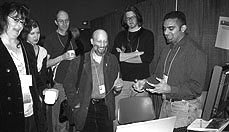Web services: Accessing the collections
Sarah Winmill, Victoria & Albert Museum, United Kingdom
http://www.vam.ac.uk
Last year we presented a paper that described how Museum’s and Archives might provide an aggregated dataset representing their collections across diverse databases, while at the same time making the aggregated collection available to the web using Web Services, a key component of Web 2.0 (See Solomon 2006: http://www.archimuse.com/mw2006/papers/solomon/solomon.html). Web Services present information in XML format and as such allow applications which use this information (‘consuming applications’) a maximum level of flexibility in the way they use data. While the standardization of datasets is exceedingly useful from the viewpoint of comprehensibility and technical accessibility for internally developed applications, there is an additional external benefit. Placing such services on the www, empowers independent third parties to use the live data in their own applications, presenting it in their own way. This is one of the factors behind the power of Web Services that sees it as a key enabling technology of the Web 2.0 concept.
The V&A’s core systems integration project (CSIP), which exemplifies this proposal, is entering its second phase. A common data model (CDM) loosely based on the SPECTRUM model has been agreed and established, and a set of basic services, which are currently exposed internally, have been developed. These services include full search and retrieve capabilities across the complete CDM comprising some 100 fields representing a collection spanning between 1.5 and 2 million objects. This has been achieved in ‘virtual’ space, allowing the source applications (i.e. the Museum’s Objects databases) untouched, while making their live data available. Security considerations have required us to consider the technical architecture in terms of our firewall and how systems are placed within the DMZ.
A demonstration application allowing Gallery Assistants to search the collection for up-to-date information on all objects to assist them with enquiries from the public has also been developed. This is currently being extended to a publicly available version which will feature in galleries and on the web. The intrinsically scalable nature of Web services technology lends itself to controlling the information made available. We would like to demonstrate these simple applications at Museums on the Web 2007. We would also like to show some of the architecture of the system (specifically how internal databases are accessed, and the nature of the required security architecture), which will be done through graphics and Powerpoint. We will also demonstrate how easily other applications can be developed on the back of the existing services.
In this way we wish to demonstrate the usefulness of rationalizing internal datasets in the context of a pre-existing model (SPECTRUM), how the power of Web Services can be leveraged to simplify web-based application-building, while also provoking feedback on the usefulness of placing such services on the www.
Finally, proceeding with this demonstration will help us to assess the degree to which other organizations are interested in this approach as we seek to build partnerships with other Museums in taking forward the concept of virtual collections that span multiple physical collections.
Mini-Workshop: Web services: Accessing the collections [Technology]
Keywords: web services, collections on-line
